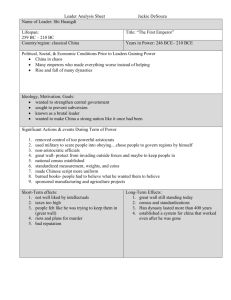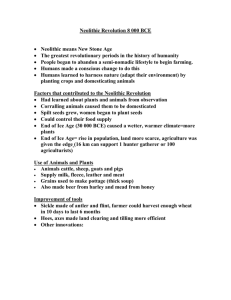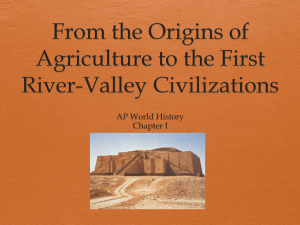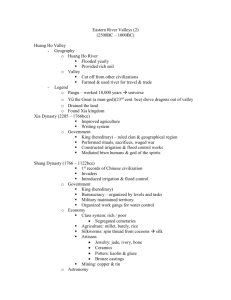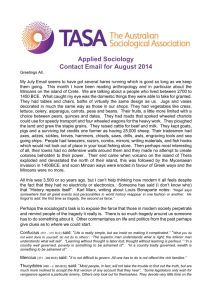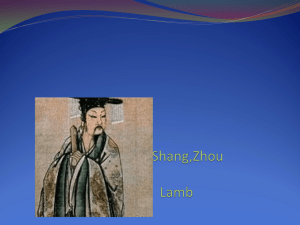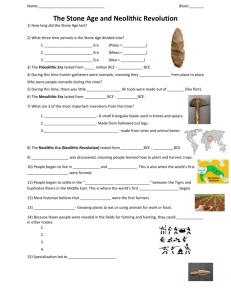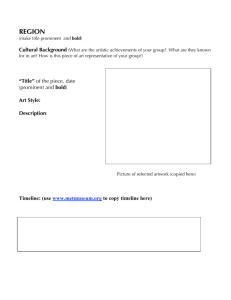AP World History Notes, Bentley Brief Edition Ch 3 Early Societies in
advertisement
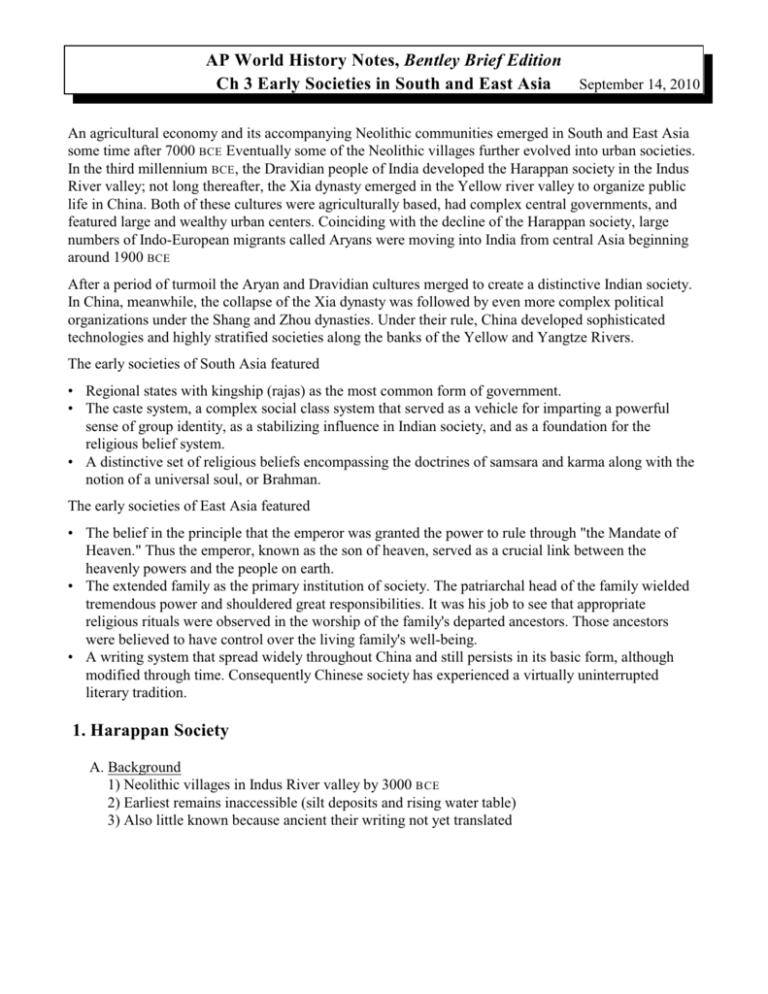
AP World History Notes, Bentley Brief Edition Ch 3 Early Societies in South and East Asia September 14, 2010 An agricultural economy and its accompanying Neolithic communities emerged in South and East Asia some time after 7000 BCE Eventually some of the Neolithic villages further evolved into urban societies. In the third millennium BCE , the Dravidian people of India developed the Harappan society in the Indus River valley; not long thereafter, the Xia dynasty emerged in the Yellow river valley to organize public life in China. Both of these cultures were agriculturally based, had complex central governments, and featured large and wealthy urban centers. Coinciding with the decline of the Harappan society, large numbers of Indo-European migrants called Aryans were moving into India from central Asia beginning around 1900 BCE After a period of turmoil the Aryan and Dravidian cultures merged to create a distinctive Indian society. In China, meanwhile, the collapse of the Xia dynasty was followed by even more complex political organizations under the Shang and Zhou dynasties. Under their rule, China developed sophisticated technologies and highly stratified societies along the banks of the Yellow and Yangtze Rivers. The early societies of South Asia featured • Regional states with kingship (rajas) as the most common form of government. • The caste system, a complex social class system that served as a vehicle for imparting a powerful sense of group identity, as a stabilizing influence in Indian society, and as a foundation for the religious belief system. • A distinctive set of religious beliefs encompassing the doctrines of samsara and karma along with the notion of a universal soul, or Brahman. The early societies of East Asia featured • The belief in the principle that the emperor was granted the power to rule through "the Mandate of Heaven." Thus the emperor, known as the son of heaven, served as a crucial link between the heavenly powers and the people on earth. • The extended family as the primary institution of society. The patriarchal head of the family wielded tremendous power and shouldered great responsibilities. It was his job to see that appropriate religious rituals were observed in the worship of the family's departed ancestors. Those ancestors were believed to have control over the living family's well-being. • A writing system that spread widely throughout China and still persists in its basic form, although modified through time. Consequently Chinese society has experienced a virtually uninterrupted literary tradition. 1. Harappan Society A. Background 1) Neolithic villages in Indus River valley by 3000 BCE 2) Earliest remains inaccessible (silt deposits and rising water table) 3) Also little known because ancient their writing not yet translated 2 AP World History Notes, Bentley Brief Edition Ch 3 Early Societies in South and East Asia B. Harappan Society and Culture 1) The Indus River a. Rich deposits but less predictable than the Nile b. Complex society of Dravidians, 3000 BCE 2) No evidence about political system 3) Harappa and Mohenjo-Daro: two main cities a. Each city had a fortified citadel and a large granary b. Broad streets, marketplaces, temples, public buildings c. Standardized weights, measures, architectural styles, & brick sizes September 14, 2010 Where did the earliest civilizations develop, and why did they develop in those locations? C. Harappan Society and Culture 1) Social distinctions, as seen from living styles 2) Religious beliefs strongly emphasized fertility 3) Harappan society declined from 1900 BCE onward a. Ecological degradation led to a subsistence crisis b. Another possibility: natural catastrophes such as floods or earthquakes c. Population began to abandon their cities by about 1700 BCE d. Almost entirely collapsed by about 1500 BCE e. Some Harappan cultural traditions maintained 2. The Indo-European Migrations and Early Aryan India A. The Aryans and India 1) The early Aryans a. Depended heavily on a pastoral economy b. No writing system, but had orally transmitted works called the Vedas c. Sacred language (Sanskrit) and daily-use language (Prakit) 2) The Vedic Age: 1500-500 BCE a. A boisterous period; conflicts with indigenous peoples b. Called indigenous people dasas–“enemies” or “subject people” c. Indra, the Aryans’ war god and military hero d. Aryan chiefdoms fought ferociously among themselves e. Most chiefdoms had leader raja, king 3) Aryan migrations in India: 1st Punjab and by 500 BCE in northern Deccan a. Used iron tools and developed agriculture b. Lost tribal organizations but established regional kingdoms What forms of writing developed in ancient civilizations? AP World History Notes, Bentley Brief Edition Ch 3 Early Societies in South and East Asia B. Origins of the Caste System 1) Caste and varna a. The meaning of caste: hereditary, unchangeable social classes b. The Sanskrit word varna, “color,” refers to social classes 2) Social distinctions in the late Vedic Age a. Four main varnas, recognized after 1000 BCE : (1) brahmins (priests) (2) kshatriyas (warriors and aristocrats) (3) vaishyas (cultivators, artisans, and merchants) (4) shudras (landless peasants and serfs) b. Later the category of the untouchables (dalit) was added, though untouchables are below the caste system, not part of it 3) Subcastes, or jati a. Represented more elaborate scheme of social classification; developed after the 6th century BCE b. Jati were determined by occupations c. Elaborate rules of jati life: eating, communication, behavior 4) In caste system, social mobility difficult but still possible a. Usually a result of group, not individual, effort b. Foreign peoples could find a place in society of the castes 5) Strongly patriarchal gender distinctions reflected in the Lawbook of Manu, a. Dealt with moral behavior and social relationships b. Advised men to treat women with honor and respect c. Subjected women to the control and guidance of men d. Women’s duties: to bear children and maintain the household 6) Sati, social custom in which widow throws self on funeral pyre 3. Religion in the Vedic Age A. Aryan Religion 1) Aryan gods a. War god, Indra b. Gods of the sun, the sky, the moon, fire, health, disease c. God Varuna: ethical concern, cosmic order 2) Ritual sacrifices were more important than ethics a. Priests were specialists of the ritual sacrifices b. Ritual sacrifices for rewards from the divine power c. Sacrifices, chants, soma 3) Spirituality underwent a shift after about 800 BCE a. Thoughtful individuals retreated to forests as hermits b. Dravidian notions of transmigration and reincarnation were adapted 3 September 14, 2010 How did civilizations develop and grow more complex before 600 BCE? What were the social effects of the Neolithic Revolution? How did social and gender identities develop pre-600 BCE? 4 AP World History Notes, Bentley Brief Edition Ch 3 Early Societies in South and East Asia B. The Blending of Aryan and Dravidian Values 1) The Upanishads, (means “sitting in front of”) works of religious teachings (800-400 BCE ) a. The religious forums: dialogues between disciples and sages b. Brahman: the universal soul c. Highest goal: to escape reincarnation and join with Brahman d. Samsara: an individual soul was born many times e. Karma: specific incarnations that a soul experienced f. Moksha: permanent liberation from physical incarnation 2) Religion and Vedic society a. Samsara and karma reinforced caste and social hierarchy b. Upanishads were also spiritual and intellectual contemplations c. Taught to observe high ethical standards: discourage greed, envy, vice d. Respect for all living things, a vegetarian diet September 14, 2010 What pre-600 BCE religions strongly influenced later eras? 4. Political Organization in Early China A. Early Agricultural Society and the Xia Dynasty 1) The Yellow River a. Water source at high plateau of Tibet b. Loess soil carried by the river’s water, hence “yellow” c. “China’s Sorrow”--extensive flooding d. Loess provided rich soil, soft and easy to work 2) Neolithic societies after 5000 BCE a. Yangshao society, 5000-3000 BCE b. Excavations at Banpo village: fine pottery, bone tools B. The Xia and Shang Dynasties a. Xia (“shyah”) ca. 2200 BCE (1) Archeological discovery of the Xia is still incomplete (2) Legendary King Yu, the dynasty founder, a hero of flood control 2) The Shang Dynasty: (“shahng”) 1766-1122 BCE a. Many written records and material remains discovered b. Bronze metallurgy, monopolized by ruling elite c. Horses & chariots traveled w/ Indo-European migrants d. Agricultural surpluses supported large troops e. A vast network of walled towns f. The Shang capital moved six times, served not only as political and military center, but became cultural, social, and economic hub of Chinese life. g. Lavish tombs of Shang kings with thousands of objects h. Shang wasn’t the only state, coexisted w/ other political powers Where did the earliest civilizations develop, and why did they develop in those locations? AP World History Notes, Bentley Brief Edition Ch 3 Early Societies in South and East Asia 5 September 14, 2010 C. The Zhou Dynasty: 1122-256 BCE (“joe”) 1) Zhou gradually eclipsed Shang 2) Mandate of Heaven, the right to rule a. The Zhou needed to justify the overthrow of the Shang b. Ruler was “the son of heaven” c. Mandate of Heaven only given to virtuous rulers d. Rulers had duty to maintain honor, justice, order & harmony e. Mandate could be removed from bad rulers and transferred to a more deserving candidate. 3) Political organization: decentralized administration a. Used princes and relatives to rule regions b. Led to a weak central government & rise of regional powers 4) Iron metallurgy spread through China in first millennium BCE 5) The fall of the Zhou a. Nomadic invasion sacked Zhou capital in 711 BCE b. Territorial princes became more independent c. The Warring States (403-221 BCE ) d. The last king of the Zhou abdicated his position in 256 BCE 5. Society and Family in Ancient China A. The Social Order 1) The ruling elites with their lavish consumption of bronze a. Hereditary aristocrats with extensive landholding, administrative and military offices, manuals of etiquette 2) Free artisans and craftsmen mostly worked for elites 3) Merchants and trade were important a. Trade networks linked China with west and south b. Oar-propelled boats traded with Korea and offshore islands 4) Peasants, the majority of population a. Landless peasants provided labor b. Lived in small subterranean houses c. Women’s work: wine making, weaving, silkworm raising d. Wood, bone, stone tools before iron was spread in the 6th century BCE 5) Slaves, mostly war prisoners B. Family And Patriarchy 1) Early dynasties ruled through family and kinship groups 2) Veneration of ancestors a. Belief in ancestors’ presence and their continuing influence b. Burial of material goods with the dead, offering sacrifices c. Family heads presided over rites of honoring ancestors’ spirits 3) Patriarchal society evolved out of matrilineal one a. The rise of large states brought focus on men’s contribution b. After the Shang, females devalued How “big” were the pre-600 BCE trading regions? How did social and gender identities develop pre-600 BCE? 6 AP World History Notes, Bentley Brief Edition Ch 3 Early Societies in South and East Asia September 14, 2010 6. Early Chinese Writing and Cultural Development A. Oracle Bones and Early Chinese Writing 1) Earliest writing used by political rulers, not merchants as in Mesopotamia & India 2) Oracle bones used by fortune-tellers a. Inscribed question, subjected to heat, read cracks b. Discovery of the “dragon bones” in 1890s 3) Early Chinese writing, from pictograph to ideograph a. More than two thousand characters identified on oracle bones b. Modern Chinese writing is direct descendant of Shang writing c. while Chinese spoke various local dialects, all Chinese used same written language B. Thought and Literature 1) Zhou literature--many kinds of books a. The Book of Change, a manual of diviners b. The Book of History, the history of the Zhou c. The Book of Rites, the rules of etiquette/rituals for aristocrats d. The Book of Songs, a collection of verses--most notable work 2) Most Zhou writings have perished How did culture play a role in unifying populations? 7. Ancient China and the Larger World A. Relations with nomadic Peoples of Central Asia 1) Nomadic peoples of the steppe lands--herders a. Exchange of products between nomads and Chinese farmers b. Nomads frequently invaded rich agricultural society, but did not imitate Chinese ways c. Nomads relied on Chinese grains and manufactured goods B. The Southern Expansion of Chinese Society 1) The Yangzi valley; dependable river; two crops of rice per year 2) The indigenous peoples of southern China a. Many were assimilated into Chinese agricultural society b. Some were pushed to hills and mountains c. Some migrated to Taiwan, Vietnam, Thailand 3) The state of Chu in the central region of Yanzi a. Challenged the Zhou for supremacy b. Adopted Chinese political and social traditions and writing Where did pastoralism persist even after the Neolithic Revolution?
